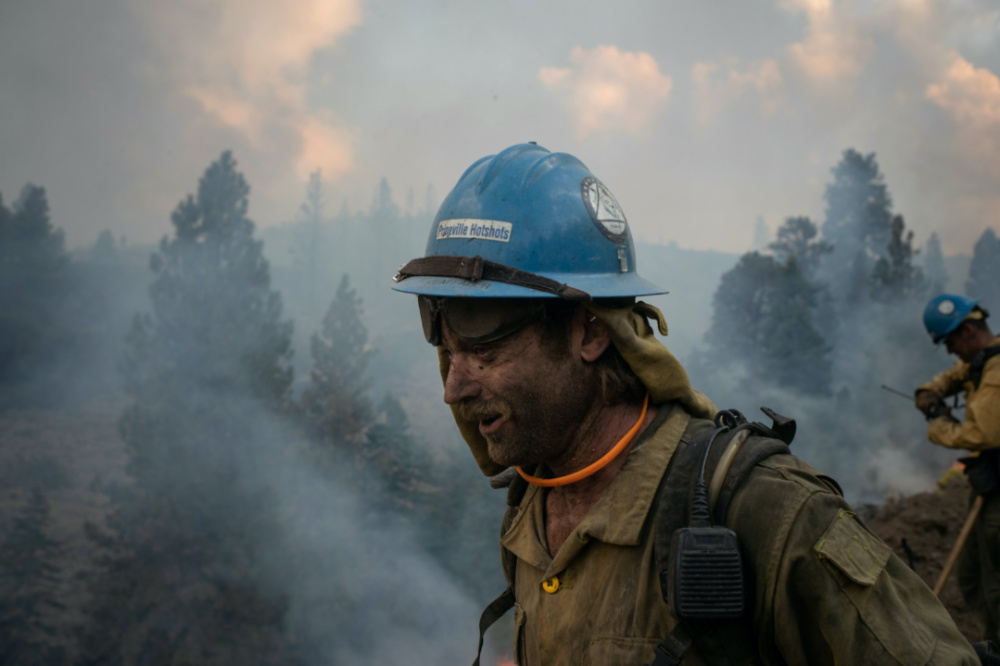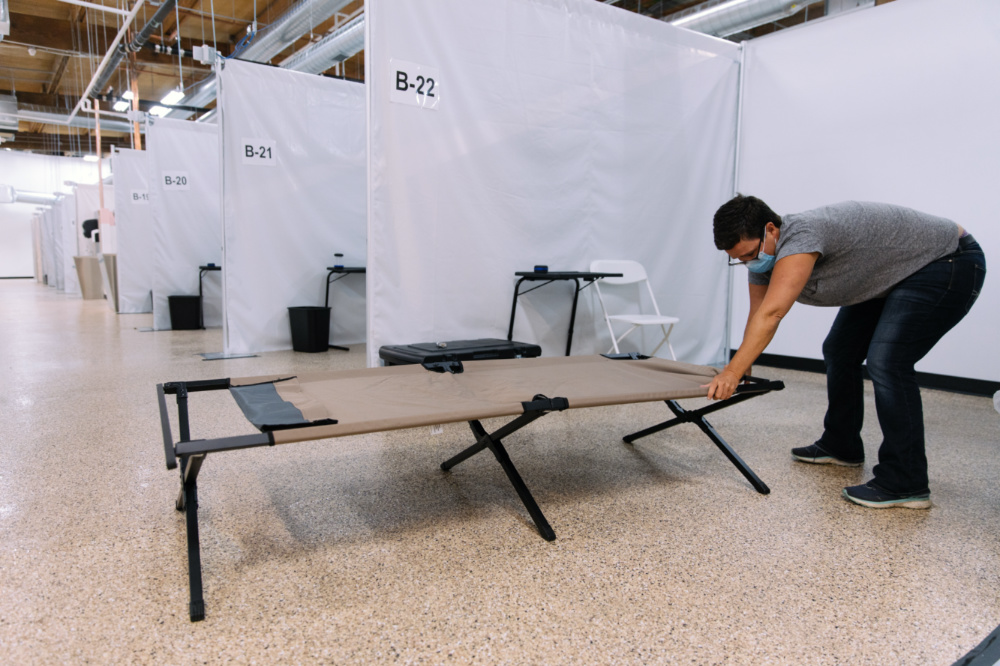
GREGORY SCRUGGS, of Thomson Reuters Foundation, reports from Seattle on how communities are grappling with declines in air quality on the US west coast as wildfires rage…
Updated: 11:45am (AEST)
Seattle, US
Thomson Reuters Foundation
Inside a row of warehouses in Seattle’s industrial district, gleaming new air ducts hint at the state-of-the-art filtration systems, ready to help hundreds of people safely recuperate indoors from COVID-19 – and smoke-filled skies.
King County, Washington, retrofitted the former automotive facilities to accommodate a potential surge of coronavirus patients in need of isolation and recovery wards, such as homeless people.

Kirk McDusky, a member of the Prineville Hotshot Crew, walks past smoke rising from the Brattain Fire in the Fremont National Forest in Paisley, Oregon, US, on 18th September. PICTURE: Reuters/Adrees Latif/File photo.
The buildings, with cots separated by curtain walls and plenty of individual shower and bathroom stalls, now have a steady stream of occupants – but they are not sick with COVID-19.
Seattle’s smoke shelters are among several emergency responses implemented in the last two weeks as wildfires rage across the western United States, burning about two million hectares and spewing toxic plumes of ash and smoke.
“[Healthy air] is not just for those of us who have money and privilege and the ability to seal ourselves in our homes and recirculate our filtered air systems, it’s for everyone.”
– Dow Constantine, King County executive.
“We’re all in this together. We have to make sure those who don’t have a place to go have a healthy environment to be in,” King County executive Dow Constantine told the Thomson Reuters Foundation.
“[Healthy air] is not just for those of us who have money and privilege and the ability to seal ourselves in our homes and recirculate our filtered air systems, it’s for everyone.”
Seattle’s so-called “healthy air center” opened on 11th September, as the air quality in some West Coast cities joined the ranks of the worst in the world, according to a global index maintained by Swiss company IQAir.
“The air quality is horrible,” said one homeless man standing outside the center who wished to remain anonymous. “I had to go to Harborview [hospital] and get another inhaler.”
In the first week since opening, the facility in Seattle regularly hit its 100 person capacity, according to county spokesman Chase Gallagher.
The Seattle area’s annual one-night count in January found nearly 12,000 homeless people.
“What is the risk of bringing people together because of COVID [versus] keeping people outside because of the smoke?” said Leo Flor, King County’s director of community and human services.
“The big plume plus the cumulative exposure to smoke really made us change that risk assessment, so that it was worth bringing people inside under the right conditions and giving them a chance not to be outside with the smoke.”
Particulate matter smaller than 2.5 micrometers, known as PM2.5, is the key measure for harmful air pollution, according to the US Environmental Protection Agency.
The particles are thinner than the width of a human hair, small enough to burrow deep into a person’s lungs and even find their way into the bloodstream.
By 15th September, air pollution had hit historic levels in five Oregon cities – Portland, Eugene, Bend, Medford and Klamath Falls, according to state officials.
In Portland, Oregon’s largest city, local officials converted the convention center into a temporary smoke shelter and started distributing KN95 masks “specifically for people who are unsheltered”, the city said in a press release last week.
“A lot of folks were keen to take the masks, and many chose to tough things out for the first few days,” said Denis Theriault, spokesman for Multnomah County, where Portland is located.
“But over time, more folks came inside as the smoke stayed,” he said in emailed comments.
Churches banded together to open a relief centre in Bend, Oregon, according to local media reports.

A handwashing station offers coronavirus-safe hygiene practices at a retrofitted homeless shelter in Seattle, on 11th September. PICTURE: Handout via Josh Lewis/King County
Government data shows that on 12th September, pollution from the fires pushed the city’s air quality over the EPA’s Air Quality Index maximum rating of 500.
The AQI considers any pollution level over 300 as hazardous.
Other cities affected by the wildfires are also finding ways to bring people in from the smoke.
In California, San Francisco’s Department of Emergency Management turned three libraries into smoke refuges on 11th September.
That same day, Vancouver, in the Canadian province of British Columbia, opened up community centres and libraries that had already been outfitted with high-powered air filters last year, according to city spokeswoman Ashton Patis.
Many cities have had emergency smoke shelters included in their disaster planning for years, as scientists warn that climate change is leading to hotter, drier summers that exacerbate wildfire risk.
“Whether it’s smoke, snow, heat or cold, being homeless is already bad for your health. The smoke is just a visible reminder of that, but it is always dangerous for your health not to have a home.”
– Leo Flor, King County’s director of community and human services.
Like Vancouver, Portland began preparing for the current scenario after devastating fires spread through the western United States in 2017, Theriault said.
Sam Carter, a founding principal of Resilient Cities Catalyst, a non-profit consultancy, praised the Seattle facility for nimbly pivoting from pandemic isolation ward to smoke shelter.
“Flexible infrastructure is critically important. We’ve long advocated for building infrastructure that can serve this kind of purpose in emergency events,” Carter said in emailed comments.
“But, much of our work also tells us that while the physical infrastructure is a crucial component, the social infrastructure and social fabric of a place can be a far more critical factor when it comes to life-and-death scenarios.”
Homelessness, an endemic social problem on the West Coast, is the root challenge in a city’s efforts to keep its residents healthy, Flor said.
“Whether it’s smoke, snow, heat or cold, being homeless is already bad for your health,” he said.
“The smoke is just a visible reminder of that, but it is always dangerous for your health not to have a home.”





